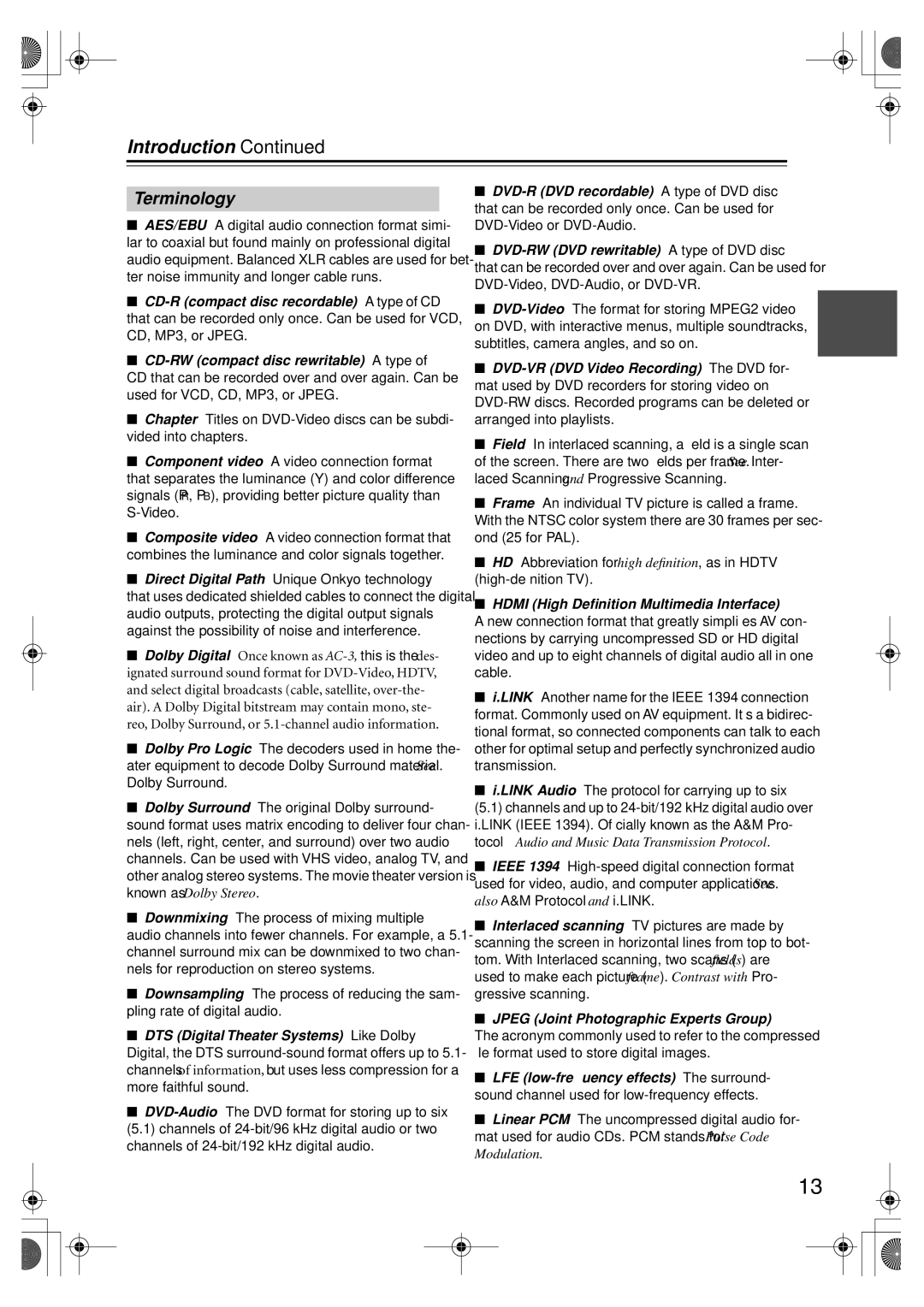RDV-1.1
Important Safety Instructions
For U.S. model
Precautions
For models having a power cord with a polarized plug
Precautions
If in any doubt, consult a qualified electrician
Moisture condensation may damage this unit
Never Touch this Unit with Wet Hands
Contents
Initial Setup Basic Playback
Important Safety Instructions Precautions
Configuring the RDV-1.1
Specifications
Introduction
RDV-1.1 Features
Power-plug adapter
Supplied Accessories
Introduction
AV cable RCA Video cable Scart cable
Disc Notes
Unsupported DVD Features
Supported Discs
DVD-Video Regions
Video CDs
Disc Content Organization
Function Support
MP3 & Jpeg Compatibility
Handling Discs
Cleaning Discs
Storing Discs
Copyright
Hdmi High Definition Multimedia Interface
Terminology
Jpeg Joint Photographic Experts Group
MPEG2 Moving Picture Experts Group
Compressed digital video format used for VCDs
Vlsc Vector Linear Shaping Circuitry
Using the Remote Controller
Installing the Remote’s Batteries
Before Use
Front Panel
Getting to Know the RDV-1.1
Display
Getting to Know the RDV-1.1
Rear Panel
IR IN/OUT
Surr Mode Audio OUT switch
MIX Audio OUT 30, 31
European model
This socket can be connected to the 12-volt trigger
Hdmi in 32
Video in component Y, PR, PB
12V Trigger
Supplied power cord should be connected here
Controlling the RDV-1.1 DVD Mode
Remote Controller
Setup button
Resolution button
Previous/Next / buttons 49, 50
Pause button
Controlling an Integra Research AV Receiver Amp Mode
AV Cables & Connectors
Connecting
Before Making Any Connections
Optical Digital Outputs
Connecting
DVD
Video Formats & RDV-1.1 Inputs & Outputs
Audio Formats & RDV-1.1 Outputs
Video Output Connections
Getting Connected
Using Component Video
Connecting a Standard TV
Using S-Video
Using Composite Video
Supplied Component
Connecting an Hdtv or Projector
HDTV, projector
Connecting a Component with an Hdmi Input
Connecting a SCART-compatible TV European model only
What is HDMI?
Using Hdmi
Hdmi & the RDV-1.1
Connecting to an AV Receiver’sVideo Inputs
Video
Audio Formats
What is i.LINK?
Connecting i.LINK-compatible Components
What is i.LINK Audio?
Using i.LINK
Sacd Playback
Connecting Several i.LINK Components
Link cables
Digital Audio Connection Dolby Digital & DTS
Connecting to an AV Receiver’s Audio Inputs
Analog Connection
Connecting a Stereo Amp
Stereo amp
Stereo amp Digital 2 Connections
Digital Connection
Compatibility of this unit with progressive-scan TVs
About the HD Component Video OUTs
Only one connection Required! Choose
Component video, S Video, or composite
Connecting Components with
Connecting a Component with an Hdmi Output
Controlling Components That Are Out of Range
Controlling the RDV-1.1 When It’s Out of Range
Components
Controlling Other Out-of-range
Connecting the Power Cord
Turning On the RDV-1.1
Turning On the RDV-1.1 with the Remote Controller
First Time Setup
Initial Setup
Press the Enter button, use
Initial Setup
Use the Left and Right
Buttons to set the Surround
Loading Discs
Basic Playback
Basic Playback
Starting, Pausing & Stopping Playback
Start To start playback, press the Play Button
Pause To pause playback, press
Load a DVD-Video disc or VCD
Navigating Disc Menus
Pressing the Top Menu button
Play the menu
Use the number buttons to spec
Selecting Chapters & Titles by Number
Ify a chapter or title number
Load a DVD-Video disc
Selecting Tracks by Number
Frame-by-Frame Playback
Fast Forward & Reverse
To resume normal playback, press the Play button
Slow-motion Playback
Adjusting the Display Brightness
Navigating MP3 Discs
Load a Jpeg disc
Viewing a Slideshow of Jpeg Images
Thumbnail-size or the Disc Navigator
Appears
Making a Playlist with the Disc Navigator
Item in the Track list except
To start the playlist, select any
Top folder and press the Play
To stop the playlist, press
Time Search
Advanced Playback
Zooming
Repeat Playback
Advanced Playback
Load a disc
Random Playback
SACD, VCD, CD Disc Random, Ran- dom Off
Memory Playback
Remote controller the Play button
Press the Enter button
Items to the Memory List
Deleting Items from the Memory List
Inserting New Items into the Memory List
Changing Items in the Memory List
Selecting Camera Angles
Selecting Soundtracks
Selecting Subtitles
Displaying Information
Last Memory
1st press
Condition Onscreen RDV-1.1 Display Normal
2nd press
3rd press
4th press
VCD & CD
Condition Onscreen RDV-1.1 Display
1st press b
Selecting the Video Input Source
Setting the Hdmi Output Resolution
Turning Off the Video Circuits
Setting the Picture’s Aspect Ratio
Using the Picture Control Menu
Remote controller The Picture Control menu appears
This section explains how to set the picture’s aspect ratio
Configuring the RDV-1.1
Menu Setting Description
Picture
Language
Operation
Configuring the RDV-1.1
Using the Onscreen Setup Menus
Arrow button
Blank screen
Picture Menu
Interlaced Setting
TV Shape
Progressive Setting
Selecting the Interlaced Setting
PAL Output Setting not North American models
Scart Output Setting European model only
Audio Menu
Digital Out/Digital1 i.LINK
Linear PCM Out
Digital Out/Digital2 Hdmi
Mpeg Out
Digital Out
Multi Channel default
Link Output Setting
Test tone is used to adjust the level of each speaker see
Analog Audio Out
Buttons to select Front Speaker
Setup button to exit setup, or
Setting the Speaker Distances
Buttons to select an option
Then press the Enter but- ton
Test Tone settings appear onscreen
Setting Levels With the Test Tone
AV Synchronization
Selecting the AV Synchronization
CD Audio Setup
Sacd Audio Setup
Buttons to set the delay time
Remote controller The settings are stored
On-Screen Language
Language Menu
Disc Menu Language
Audio Language
Operation Menu
Display Menu
Remote Confirmation
Parental Lock
Select Parental Lock-On,
Digit security code
Priority Contents
Initial Setup Menu
Auto power off
Selecting Other Languages
Use this list when specifying other languages
Language Code List
Language Code
See Remote Control Codes on
Entering Remote Control Codes
Controlling Other Components
Look up the appropriate remote
Controlling Other Components
Remote Control Codes
RCA
Noblex
Press the VCR Mode button
Press the TV Mode button
Controlling a TV Controlling a VCR
Mode
Learning the Commands of Other Remote Controllers
Deleting the Learnt Commands of All Modes
Deleting the Learnt Commands of One Mode
Press the same Mode button again
Press the Amp Mode button again
Symptom Possible cause Remedy
Troubleshooting
Audio Out settings?
Troubleshooting
Abnormal Behavior
Restoring the Default Settings
Specifications
Memo
Memo
Onkyo Europe Electronics GmbH
Onkyo U.S.A. Corporation

